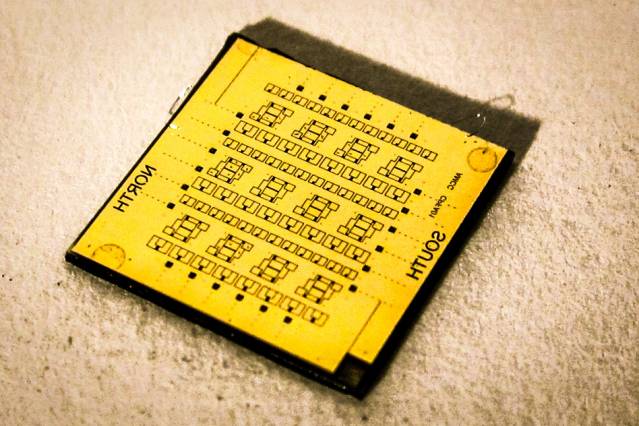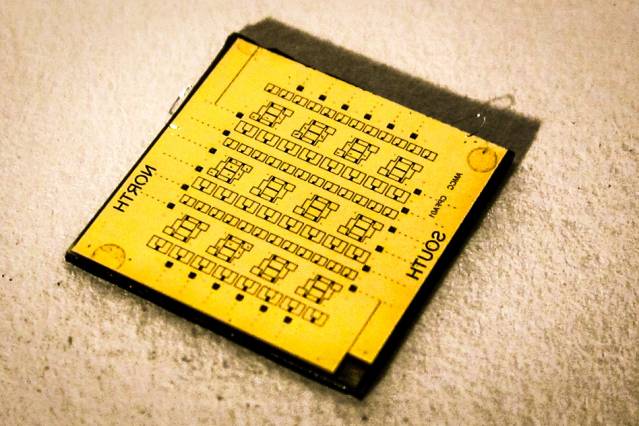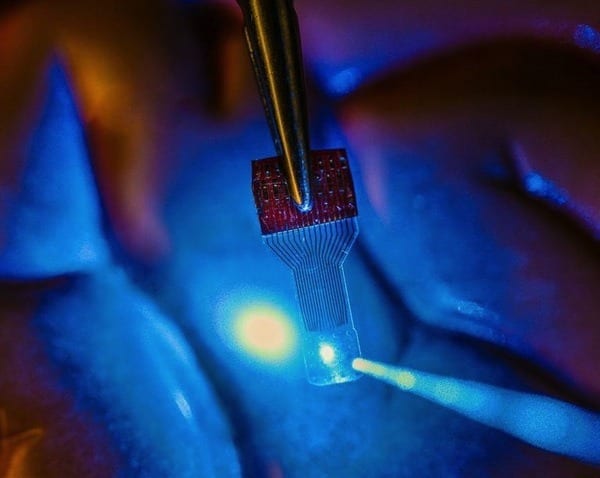
Photo: Adam N. McCaughan
New circuit design could unlock the power of experimental superconducting computer chips.
Computer chips with superconducting circuits — circuits with zero electrical resistance — would be 50 to 100 times as energy-efficient as today’s chips, an attractive trait given the increasing power consumption of the massive data centers that power the Internet’s most popular sites.
Superconducting chips also promise greater processing power: Superconducting circuits that use so-called Josephson junctions have been clocked at 770 gigahertz, or 500 times the speed of the chip in the iPhone 6.
But Josephson-junction chips are big and hard to make; most problematic of all, they use such minute currents that the results of their computations are difficult to detect. For the most part, they’ve been relegated to a few custom-engineered signal-detection applications.
In the latest issue of the journal Nano Letters, MIT researchers present a new circuit design that could make simple superconducting devices much cheaper to manufacture. And while the circuits’ speed probably wouldn’t top that of today’s chips, they could solve the problem of reading out the results of calculations performed with Josephson junctions.
The MIT researchers — Adam McCaughan, a graduate student in electrical engineering, and his advisor, professor of electrical engineering and computer science Karl Berggren — call their device the nanocryotron, after the cryotron, an experimental computing circuit developed in the 1950s by MIT professor Dudley Buck. The cryotron was briefly the object of a great deal of interest — and federal funding — as the possible basis for a new generation of computers, but it was eclipsed by the integrated circuit.
“The superconducting-electronics community has seen a lot of new devices come and go, without any development beyond basic characterization,” McCaughan says. “But in our paper, we have already applied our device to applications that will be highly relevant to future work in superconducting computing and quantum communications.”
Superconducting circuits are used in light detectors that can register the arrival of a single light particle, or photon; that’s one of the applications in which the researchers tested the nanocryotron. McCaughan also wired together several of the circuits to produce a fundamental digital-arithmetic component called a half-adder.
Resistance is futile
The Latest on: Superconducting circuits
[google_news title=”” keyword=”Superconducting circuits” num_posts=”10″ blurb_length=”0″ show_thumb=”left”]
via Google News
The Latest on: Superconducting circuits
- 3 Quantum Computing Stocks That Could Be Multibaggers in the Making: April Editionon April 27, 2024 at 11:00 am
InvestorPlace - Stock Market News, Stock Advice & Trading Tips Quantum computing technology and applications across sectors are advancing ...
- Plan for Australia to stay ‘ahead of the pack’ in cutting-edge computingon April 25, 2024 at 3:00 pm
The federal government is investing $18 million to link the country’s major universities with industry groups and strategic partners to boost the country’s quantum edge.
- MIT scientists tune the entanglement structure in an array of qubitson April 24, 2024 at 5:36 pm
Entanglement is a form of correlation between quantum objects, such as particles at the atomic scale. This uniquely quantum phenomenon cannot be explained by the laws of classical physics, yet it is o ...
- Scientists tune the entanglement structure in an array of qubitson April 24, 2024 at 10:02 am
Entanglement is a form of correlation between quantum objects, such as particles at the atomic scale. The laws of classical physics cannot explain this uniquely quantum phenomenon, yet it is one of ...
- MIT Technology Reviewon April 23, 2024 at 2:00 pm
A detailed study confirms that record-setting magnets built by the Plasma Science and Fusion Center and Commonwealth Fusion Systems meet the requirements for an economical, compact power plant.
- The big quantum chill: Scientists modify common lab refrigerator to cool faster with less energyon April 23, 2024 at 9:38 am
By modifying a refrigerator commonly used in both research and industry, researchers at the National Institute of Standards and Technology (NIST) have drastically reduced the time and energy required ...
- Magnetic Control Achieved Over Superconductor Properties: A Scientific Breakthroughon April 20, 2024 at 8:35 am
Innovations in superconductivity are pushing the boundaries of modern technology. While a significant focus lies on enabling currents with zero resistance at higher temperatures, the ability to ...
- Physicists Created an Exotic Superconductor Controlled by Magnetismon April 19, 2024 at 4:29 pm
While the FFLO state has been observed in superconducting materials as a bulk property, confining it to a Josephson junction in such a way that it can be controlled allows physicists to study the ...
- Future quantum computers could use bizarre 'error-free' qubit design built on forgotten research from the 1990son April 19, 2024 at 3:00 am
Qubits can be made by floating a suspended electron over a pool of liquid helium rather than being embedded them a solid-state crystal — which leads to impurities and errors.
- The UK’s second commercial quantum computer has launchedon April 18, 2024 at 3:57 am
California-based quantum circuitry company Rigetti has brought a commercially available quantum computer to the UK. Only the second in the country, it was installed in collaboration with Oxford Instru ...
via Bing News











